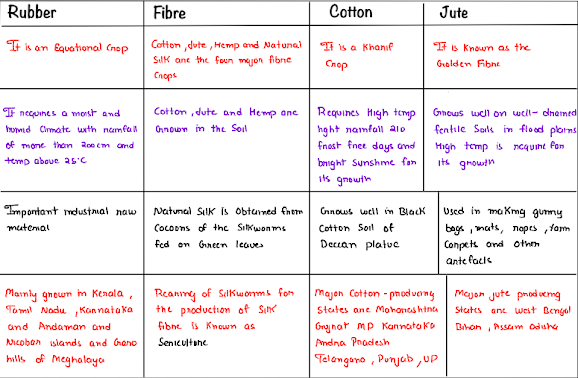Agriculture Class 10 Notes | Geography Chapter 4 Class 10 Notes. On this page, you can view notes for Agriculture Class 10 | Geography Chapter 4 Notes Class 10.
Agriculture Class 10 Notes | Geography Chapter 4 Class 10 Notes
Types of farming
The cultivation method depends upon the Characteristics of the Physical Environment. technological know-how and Socio-Cultural practices. Farming varies from subsistence to commercial type. In different parts of India, the following Farming systems are practiced.
1) Primitive Subsistence farming
It is a slash - and burn Agriculture. Farmers clear a patch of land and produce corals and Other foods and use primitive tools like hoe, dao, and digging sticks involving family labor.
When soil fertility decreases the farmers shift and clean a fresh patch of land for cultivation.
It is known by different names in different parts of the country. It is known as thrumming in the North Eastern States Pam/ou in Manipur and Dipa in Bastar District of Chhattisgarh and Andaman and the Nicobar Islands.
land productivity is low in this type of agriculture and farming depends on monsoon.
2) Intensive Subsistence farming
This type of farming is practiced in areas of high population pressure on land.
It is labor-intensive farming. Where high doses of biochemical inputs and irrigation are used for higher production.
3) Commercial Farming
This type of farming uses higher doses of modern inputs such as High Yielding a Variety of CKYV) seeds chemical fertilizers, insecticides, and pesticides to Obtain Higher productivity.
Plantation
Is a type of commercial farming in which a single crop is grown in a large area. Plantations couch large tracts of land, Using capital-intensive inputs, with the help of migrant laborers. All the Eg Tea, Coffee, Rubber, Banana, Sugarcane.
Cropping pattern
India has three cropping seasons
- Rabi
- Kharif
- Zaid
Major Crops in India
A Variety of food and non-food crops are grown in different parts of India depending upon the variations in soil climate and Cultivation practices major crops grown in India are.
- Rice
- Wheat
- Millets
- Pulses
- Tea
- Coffee
- Sugarcane
- Oil Seeds
- Cotton
- Jute
We will now discuss all of this one by one in detail.
Rice
- It is a Kharif Crop
- Requires High temp and high humidity with annual Rainfall above 100cm
- India is the second largest producer of rice in the world after China
- Grown in the plains of north and north - Eastern India coastal areas and the detailed regions
Wheat
- It is a Rabi crop
- Requires a cool growing season and bright sunshine at the time of ripening
- Requires so -75cm of annual rainfall Evenly distributed Over the growing season
- The Ganga - Salty plains in the northwest and black soil Region of the Deccan are two main wheat growing zones in India
- It is the second most important cereal crop and main food Crop, in the north and north Western part of India
Millets
- Jowar, Bajra, and Ragi are the important millets grown in India
- These are known as coarse grains and have very high nutritional value
Maize
- It is a Kharif crop
- Requires temperature between 21 degrees C to 27 degrees C and grows well in Old alluvial soil
- Used both as food and fodder
- Major maize-producing states are Karnataka, Madhya Pradesh, UP, Bihar, Andria Pradesh, and Telangana
Pulses
India is the largest producer and Consumer of pulses in the world
Pulses are the major source of protein in a Vegetarian diet
Major pulses-producing states are M.P, Rajasthan, Maharashtra, UP, and Karnataka
Major pulses grown in India are Arhar, Urad, moong, Masur, Peas, and Gram
Food crops other than Grains
Sugarcane
It is tropical as well as subtropical crops
Grows well in hot and humid climates with temperatures of 212 to 27C and annual rainfall between 75cm to 100cm
Can be grown On a Variety of soils
Needs manual labor
India is the second largest producer of sugarcane only after Brazil Sugarcane is the main source of Sugar, Gur, and molasses.
The major sugarcane-producing states are - UP, Bihar, Maharashtra, Karnataka, Tamil Nadu Andhra Pradesh, Bihar, Telangana Punjab, and Haryana.
Oil Seeds
Different 011 Seeds are grown in approximately 12% of the total Cropped area of India. The main oil seeds produced in India are.
- Groundnut - This is a Kharif crop and accounts for the help of the major oil seeds produced in India. Gujrat is the largest producer of groundnuts.
- Mustard - Rabi Crop
- Sesamum - Kharif crop in the north and Rabi crop in South India
- Castan Seeds - Grown as both Rabi and Kharif crop
- Linseed - Rabi Crop
- Coconut
- Soyabean
- Cotton Seed
- Sunflower
Tea
- Important beverage crop introduced by the British in India
- The tea plant grows well in tropical and SubTropical climates with deep and fertile well-drained soil rich in Humus and Organic matter
- Tea is a labor-intensive industry
- Major tea-producing states are Assam, the hills of Darjeeling and Jalpaiguri districts, West Bengal, Tamil Nadu, and Kerala
Coffee
Yemen coffee is produced in India and this variety of coffee is in great demand all over the world its cultivation was introduced on the Baba Budan Hills and is confined to the Nilgiri in Karnataka Kerala and Tamil Nadu.
Horticulture Crops
India is a producer of tropical as well as temperate fruits . Major crops produced are pea cauliflower onion , cabbage , tomato, brinjal, and potato some of the famous horticulture crops grown in India.
- Mangoes - of Maharashtra , Andra Pradesh, Telangana, UP, and West Bengal
- Oranges - of Nagpur and Chennapongee, bananas of Kerala, Mizoram ,
- Maharashtra and Tamil Nadu
- Uchi & Guava - of UP and Bihar
- Pineapples - of Meghalaya
- Grapes -of Andra Pradesh ,Telangana, and Maharashtra
- Apples , pears, apricots and walnuts - of Jammu & Kashmir and Himachal Pradesh
Non-Food Crops
Institutional reform
Major institutional reform includes collectivization consolidation of land Holding development of cooperative societies abolition of Zamindari and the First Five Year Plan.
Technological reform
The laws of land reform were Entailed but their implementation was lacking Somewhere The Gov of India in 1960 -the 70s Introduce agricultural reforms to improve Indian agriculture 1175C Green and white revolution.
Agricultural finance
Establishment of Grammer C Regional Banks, cooperative societies, and banks for providing loan facilities .
Land Development Programme
In the 1980s and 1990s, many institutional and technical reforms were made under comprehensive LDP.

%20(1).webp)



